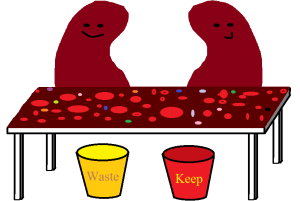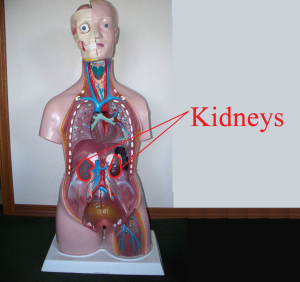The work of kidneys goes on without much fanfare, and it’s easy to ignore them — unless something goes wrong. Or you’re told that something might go wrong. When my doctor wrote prescriptions and said that I’d have to have blood drawn frequently to make sure that those drugs don’t harm my kidneys, well, suddenly I had have a new respect for those little organs.
Aside from a general, “somewhere in the abdomen,” I wasn’t even sure exactly where the kidneys are located. Now I know.
Learning where they’re located didn’t mean I knew what the kidneys do, though.
Some days I wonder if I ever learned anything useful in school! A zillion years of formal education (with pretty good grades), and I never had to learn basic anatomy. That seems so wrong – and is why my children are learning some basics about how their bodies work. But I digress.
Whenever something goes into people’s mouths (steak, tofu, twinkies, salad, asparagus, ice cream…), their bodies use the nutrients they need, and sends waste into the bloodstream. The bloodstream then flows through the kidneys, which are incredibly complex filters.
They do more than act as filters, though.
 Our kidneys analyze the stuff they’re sent and sort everything. Electrolytes that the body needs (sodium, potassium, etc) are measured out in just the right amounts and allowed into the bloodstream. Waste and extra water is shuffled off to the bladder for removal as urine.
Our kidneys analyze the stuff they’re sent and sort everything. Electrolytes that the body needs (sodium, potassium, etc) are measured out in just the right amounts and allowed into the bloodstream. Waste and extra water is shuffled off to the bladder for removal as urine.
It doesn’t stop there, though. In addition to filtering out wastes, these fist-sized organs release one hormone to tell our bone marrow to make red blood cells, another that helps regulate blood pressure, and a third substance involved in calcium maintenance in the bloodstream. When the kidneys aren’t doing their job, these things don’t get done. The kidneys are important!
But I still had some questions.
- Why are lab tests that check kidney function called a renal panel?
- Why are kidney doctors called nephrologists?
- What about those lab tests?
Slowly, I’m learning.
Renal – The Latin word for kidney is ren, plural renes.
Nephrology – Just as the lungs are full of little air sacks called alveoli, the kidneys are full of little tubes called nephrons. (So why do we have pulmonologists, instead of alveolologists?)
This didn’t just turn into an etymology blog, but if you’re into word origins, it’s interesting to note that νεφρός (transliterated nephros) is the Greek word for kidney.
Labs – A renal panel includes electrolytes (sodium, potassium, chloride, and bicarbonate), blood urea nitrogen, creatinine, glucose, albumin, calcium, and phosphate. My doctor has never ordered a renal panel. Either she orders a CMP (which includes all these tests and more), or a few select tests.
BUN – blood urea nitrogen – the normal range for this test is around 6-20 mg/dL (or 2.1-7.1 mmol/L) in adults, although there can be slight variations between different labs (my lab uses 7-23 as its normal range). Labs usually print their reference range right on the report, which is nice because we don’t have to guess. High numbers can indicate a problem, but can also be due to dehydration or a high protein diet.
Creatinine – according to LabTestsOnline, the normal range for this test depends on age and gender: 0.6-1.1 for women age 18-60, and 0.9-1.3 for men in the same age range are reasonable numbers. Again, labs can vary. My lab’s normal range for this blood test is 0.4-1.0. As with BUN, high numbers can indicate a kidney problem, but can also be due to dehydration. Note that creatinine can also be checked with a urine test.
BUN/CRE Ratio – some labs will also report the ratio of blood urea nitrogen to serum creatinine. Ratios are interesting. The individual components can fall within the normal range, yet the ratio of one to the other be out of whack (to use a technical term).
eGFR – Estimated Glomerular Filtration Rate – this is a calculation (not a separate test) based on serum creat and a bunch of other details. The National Kidney Foundation has a handy-dandy eGFR calculator available online. And if you wonder, as I did, where they came up with a name like glomerular, the glomerulus is one little part of every nephron.
Since these lab tests are easily affected by what people eat and how much they’ve had to drink, it’s easy to see why doctors don’t worry about fluctuations of one or two numbers. That explains why, if something is outside the normal range, my doctor orders a re-test. It’s the long-term trend she’s looking for, not the occasional blip caused by my steak & eggs breakfast.
***
For more reading about the kidneys:
- How Your Kidneys Work (National Kidney Foundation)
- How Your Kidneys Work (Discovery Health)
- The Kidneys and How They Work (NKUDIC)
- Renal Troubles Spell Acute Injury Risk
- Early dialysis may not improve kidney failure outcomes


I always loved science and biology in school, and I know I’d have loved learning anatomy, though it wasn’t taught. (I’ve got a fair idea of the anatomies of frogs and earthworms, however!) Thanks for the mini-lesson on the kidneys. I love word entemology, too!
Hope you’re feeling good, Socks, and that life is calming down a bit after daughter’s doc appointments and son’s broken arm. You’re on my mind. 😉
🙂
Son’s arm appears to be healed. Daughter’s condition is worsening.
I enjoyed science, too, but refused to take biology in high school. We were required to have three science credits, and I knew I’d have six, so when a teacher told me that I had to take biology, it got my hackles up. Never tell me what I HAVE to do, or I’ll prove to you that I have other choices. 😉 I’ve mellowed a bit over the years, but that’s how I felt about it back then. It’s been fun, these past couple years, to do biology alongside my kids. I think I’m having more fun now than I would have back when I was in school. I’ve purchased an A&P text, so hope to slowly make my way through it and see how much I can learn.